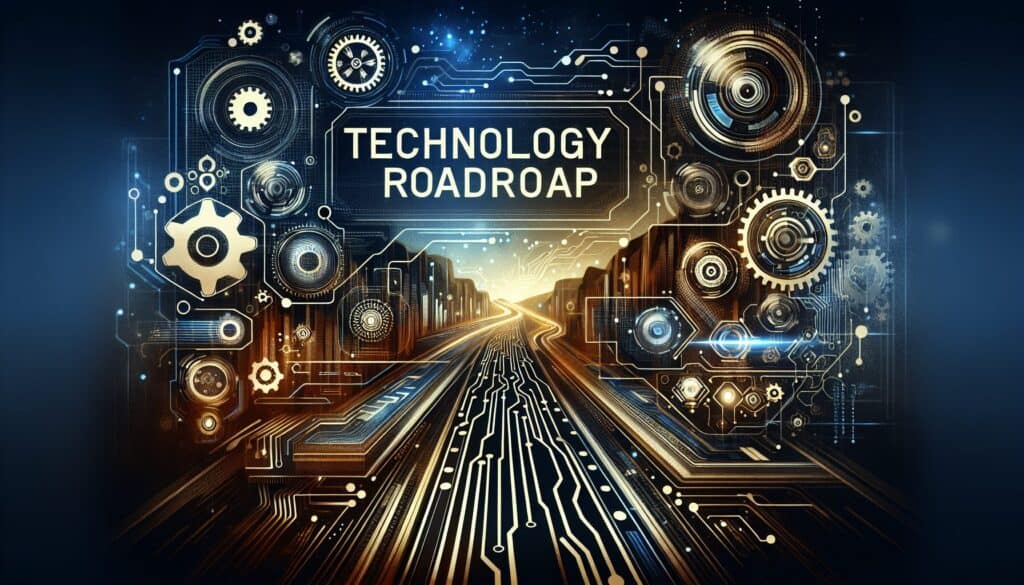Erstellung eines Plans, der kurz- und langfristige Ziele mit spezifischen Technologielösungen verbindet.
- Methodologien: Kunden & Marketing, Ideenfindung, Produktdesign
Technologie-Fahrplan

Technologie-Fahrplan
- Agile Methodik, Änderungsmanagement, Kontinuierliche Verbesserung, Innovation, Projektmanagement, Risikomanagement, Fahrplan
Zielsetzung:
Wie es verwendet wird:
- Sie wird von Unternehmen verwendet, um Technologiepläne zu kommunizieren, Technologielücken zu identifizieren und die Technologieentwicklung mit der Geschäftsstrategie abzustimmen. Sie umfasst die Visualisierung von Zeitplänen, Ressourcen und technologischen Abhängigkeiten.
Vorteile
- Richtet die Technologie an der Unternehmensstrategie aus, verbessert die Kommunikation, hilft bei der Priorisierung von Investitionen und verwaltet Risiken.
Nachteile
- Die Erstellung und Pflege kann kompliziert sein, kann schnell veralten, wenn sie nicht regelmäßig überprüft wird, und erfordert funktionsübergreifende Beiträge.
Kategorien:
- Ideenfindung, Produktdesign, Projektmanagement
Am besten geeignet für:
- Strategische Planung und Abstimmung von Technologieinitiativen auf die allgemeinen Unternehmensziele im Laufe der Zeit.
Technologie-Fahrplan methodology is particularly beneficial in sectors such as pharmaceuticals, where it can guide the development of new drug technologies by illustrating timelines for research, regulatory approvals, and market launch. In the automotive industry, it has been employed to plan the integration of electric and autonomes Fahrzeug technologies, aligning innovations with consumer demands and regulatory changes. It proves useful during the early stages of R&D projects, where stakeholders can visualize the interplay between emerging technologies and market trends, ensuring that resources are allocated efficiently. Participation typically includes cross-functional teams comprising engineers, product managers, and business strategists, facilitating a comprehensive understanding of both technical and market requirements. Educational institutions and research organizations also utilize roadmaps to secure funding and collaborative opportunities by presenting clear developments and expected outcomes. Industries utilizing these roadmaps often see improved alignment between product development timelines and corporate objectives, which significantly mitigates risks associated with innovation stagnation or misaligned technology investments, ensuring that the pursuit of technological excellence mirrors the strategic aspirations of the organization. Enhanced communication channels established through this methodology enable stakeholders to convey technology plans effectively, thereby driving accountability and encouraging buy-in from all participants involved in the initiative.
Die wichtigsten Schritte dieser Methodik
- Identify business objectives and technology needs.
- Create a vision or technology direction statement.
- Map current technologies and capabilities.
- Identify technology gaps between current state and desired future state.
- Develop technology options to fill identified gaps.
- Prioritize technology initiatives based on alignment with business objectives.
- Develop a timeline for technology development and implementation.
- Define resource requirements for each initiative.
- Establish metrics for measuring success and technology performance.
- Regularly review and update the technology roadmap.
Profi-Tipps
- Integrate stakeholder feedback at various Roadmap stages to enhance alignment and foster ownership among teams.
- Utilize scenario planning to simulate potential future trends and disruptions, ensuring roadmaps remain adaptable.
- Regularly review and update the roadmap to reflect shifts in market dynamics and technological advancements, maintaining relevance.
Verschiedene Methoden lesen und vergleichen, Wir empfehlen die
> Umfassendes Methoden-Repository <
zusammen mit den über 400 anderen Methoden.
Ihre Kommentare zu dieser Methodik oder zusätzliche Informationen sind willkommen auf der Kommentarbereich unten ↓ , sowie alle ingenieursbezogenen Ideen oder Links.
Historischer Kontext
1949
1950
1950
1960
1960
1960
1960
1940
1950
1950
1958
1960
1960
1960
1960
(wenn das Datum nicht bekannt oder nicht relevant ist, z. B. "Strömungsmechanik", wird eine gerundete Schätzung des bemerkenswerten Erscheinens angegeben)















Verwandte Artikel
METS-Kalorien-Rechner
Meta-Analyse
Nachrichten-Mapping
Mentalmodell-Diagramme
Maximal zulässige Druck- und Zugkräfte
Materialbedarfsplanung (MRP)